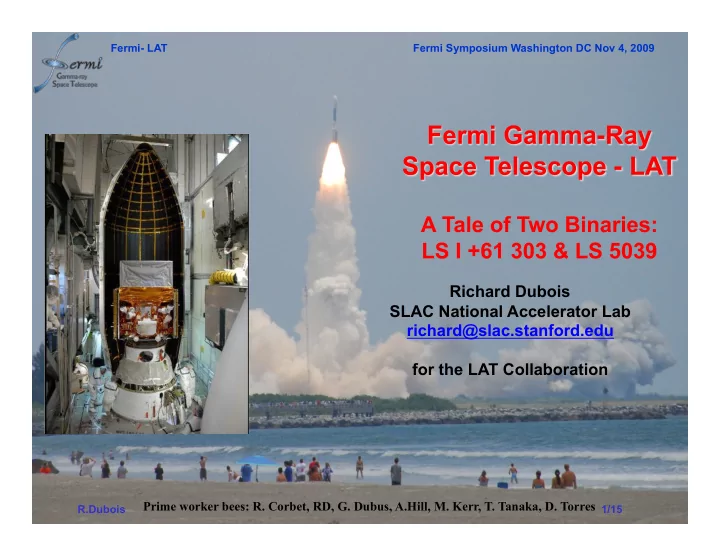

Fermi- LAT Fermi Symposium Washington DC Nov 4, 2009 Richard Dubois SLAC National Accelerator Lab richard@slac.stanford.edu for the LAT Collaboration Prime worker bees: R. Corbet, RD, G. Dubus, A.Hill, M. Kerr, T. Tanaka, D. Torres R.Dubois 1/15
Fermi- LAT Fermi Symposium Washington DC Nov 4, 2009 R.Dubois 2/15
Fermi- LAT Fermi Symposium Washington DC Nov 4, 2009 Orbital period ~26.5 d Superior EGRET: γ =-2.19±0.07 conjunction apastron MAGIC: γ =-2.6±0.2 Veritas: γ =-2.6±0.2 Be star peri- astron Inferior Veritas conjunction 2 kpc C.Aragona et al (ApJ 698, 514 (2009)) MAGIC R.Dubois 3/15 ApJ, 650:L123–L126, 2006
Fermi- LAT Fermi Symposium Washington DC Nov 4, 2009 Backscatter to observer: softer spectrum, Orbital period ~26.5 d higher flux Superior Dimmest scattering conjunction apastron target Be star Brightest scattering peri- target: astron Forward scatter to observer: harder bright @ GeV Inferior spectrum, lower flux γγ annihilation @ TeV conjunction 2 kpc R.Dubois 4/15
Fermi- LAT Fermi Symposium Washington DC Nov 4, 2009 • ID : position + orbital period Residuals map • LS I +61°303 fitted to R.A.=40.076, Dec.=61.233 with 95% error radius of 1.8’. This location is consistent with the known position of the optical counterpart. • Flux variability is also clearly evident R.Dubois 5/15
Fermi- LAT Fermi Symposium Washington DC Nov 4, 2009 • We detect a periodicity in the LS I +61°303 light curve at 26.6 ± 0.5 days • Folded light curve indicates peaks of emission around periastron. Bkg region See no statistically significant dependence of spectrum on phase R.Dubois 6/15
Fermi- LAT Fermi Symposium Washington DC Nov 4, 2009 Exponential cutoff form clearly favoured over power law: chance prob for PL ~10 -9 Unbinned likelihood fitting of the phase averaged flux yields F = A E - Γ exp(-E/E c ) Flux (E>100 MeV) = 0.82 ± 0.03 (stat) ± 0.07 (syst) 10 -6 ph/cm 2 /s Points: Fitted energy bins Red: unbinned power law fit envelope Γ = 2.21 ± 0.04 (stat) ± 0.06 (syst) Blue: MAGIC phases 0.6-0.75 Black circles: Veritas (systematic errors not shown) E c = 6.3 ± 1.1 (stat) ± 0.4 (syst) GeV ApJL: 701 (2009) L123-L128 R.Dubois 7/15
Fermi- LAT Fermi Symposium Washington DC Nov 4, 2009 Dubus et al: A&A 477, 691-700 (2008) • O6.5 companion star • nature of compact object not nailed down • HESS observed orbital period: 3.91 days • no EGRET modulation seen – spatial coincidence only R.Dubois 8/15
Fermi- LAT Fermi Symposium Washington DC Nov 4, 2009 HESS HESS Sierpowska-Bartosik & Torres HESS sees high and low states, Depending on phase: Fermi γγ absorption huge difference in obs flux γγ • higher flux, harder spectrum at INFC • lower, softer at SUPC • model Fermi by injecting e’s with spectrum that matches HESS R.Dubois 9/15
Fermi- LAT Fermi Symposium Washington DC Nov 4, 2009 “background” PSR 1826-1256 PSR 1826-1256 removed using its pulse phase LS 5039 with model subtraction of other sources LS 5039 LS 5039 sits in a bath of galactic diffuse emission! Detected at more than 24.5 σ σ R.Dubois 10/15
Fermi- LAT Fermi Symposium Washington DC Nov 4, 2009 • We detect a periodicity in the LS 5039 light curve at 3.91±0.05 days • Folded light curve indicates peaks of emission around periastron – out of phase with VHE. R.Dubois 11/15
Fermi- LAT Fermi Symposium Washington DC Nov 4, 2009 Flux Fermi HESS HR Blue – superior conjunction Top: Flux > 100 MeV Red – inferior conjunction Bottom: Hardness ratio – (1-100) GeV/ (0.1-1) GeV We see an exponential cutoff here too. Insufficient statistics at INFC to confirm exp Indications of spectral variability, most cutoff. Bulk of data is at SUPC. pronounced between inferior and superior conjunction ApJL 706 (2009) L56 R.Dubois 12/15
Fermi- LAT Fermi Symposium Washington DC Nov 4, 2009 LS 5039 LS I +61°303 Average spectrum: Average spectrum: Index: 1.9, Cutoff: 2.1 GeV Index: 2.21, Cutoff: 6.3 GeV • Exponential cut-offs are reminiscent of the Fermi pulsar spectra; is this a sign of magnetospheric emission in these systems? • Difficult to reconcile with orbital variability of spectrum • Further investigation required R.Dubois 13/15
Fermi- LAT Fermi Symposium Washington DC Nov 4, 2009 Preliminary Preliminary Preliminary Hardness ratio Courtesy: Paul Ray RXTE – LAT correlation - pre Mar ’09 - post Mar ‘09 • Flux increase of ~40% after March ‘09 • more flux in apastron region wrt periastron Flux > 100 MeV • odd feature at phase 0.5-0.6 • “flares” appear to correlate with x-ray? • March event a change of state? • no x-ray counterpart to July flare • any relation to 4 year radio period? R.Dubois 14/15
Fermi- LAT Fermi Symposium Washington DC Nov 4, 2009 • First positive identifications of LS I +61 303 & LS 5039 at GeV energies • Observation of exponential cutoff spectrum in both cases – Looks suspiciously like the spectra from our pulsars… • We’ll keep looking as more data comes in • … meanwhile, look for other “LS”s in the galaxy… R.Dubois 15/15
Recommend
More recommend